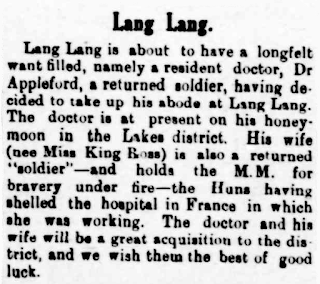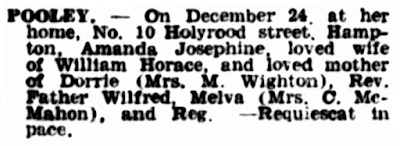The worst flood in the history of Koo Wee Rup occurred on December 1, 1934 and the Fallen Soldiers' Memorial Hospital had to be evacuated. I was hoping that the local paper, the
which was published weekly, would have had an account of this, however they did not produce an issue until December 20, 1934. As they reported -
Fallen Soldiers' Memorial Hospital in a flood; must be the 1924 as in 1929, an enclosed verandah was erected around the original building.
Image: Koo Wee Rup Swamp Historical Society
The report mentions four people by name and I thought we would look at who they were.
Clarence Fenner
Clarence's surname was listed as Renner in The Argus report, but listed as Clarence Fenner in a Morwell Advertiser report (3) about the evacuation. As I cannot find any reference anywhere to a Clarence Renner, I believe this is actually Clarence Charles Fenner, born February 6, 1919 to Charles Stanley Victor and Esther (nee Burden) Fenner in Frankston, so he would have been about 15 during the flood (4).
Charles was listed in the Electoral Roll as a contractor and the family were living in Frankston, when Clarence was born. They then spent a few years in Morwell in the early to mid 1920s, where perhaps Charles was employed on State Electricity Commission projects such as the construction of the Yallourn Power Station. The family then moved around various Melbourne suburbs, until the early 1940s when they lived at 30 Sutton Grove in Richmond. Clarence, or Clarrie, as he was called, had three older brothers - Harold, who worked for the Brighton Gasworks Company and tragically died in 1927 when he fell 30 feet whilst constructing a new gasometer; and Stanley and Frank (5).
Clarrie, whose occupation was a driver, married Evelyn Smith in 1937 and enlisted in the Army in June 1940 and was discharged in October 1945. From the 1960s, the Electoral Rolls show the family was living at 1 Biran Court, in Reservoir. Clarence died March 6, 1999 and is buried at Fawkner Cemetery with his son Brian (1947-2013). His wife Evelyn who died in 1980 is buried in the adjoining grave with their son Stanley (1939-1963) (6).
Why was Clarrie having an operation at the Koo Wee Rup Hospital in 1934 when, according to the Electoral Rolls, his parents were living in the suburbs of Melbourne? The doctor in Koo Wee Rup was Dr Alan Hewitt and in Lang Lang, Dr Sydney Appleford, so the family may have had a connection to either doctor or there was possibly a family member in the town, who could have visited him, but I don't the reason. I wonder how many times during his life, Clarrie told people the exciting story of being evacuated through the roof at the Koo Wee Rup Hospital? It was very fortunate that Charles Renner and Mr Gannon had the nous and the ability to cut a whole in the roof to enable the rescue of the patients.
Mr Gannon
Helped Mr Fenner rescue his son through the roof. I can’t find a Gannon listed on the Electoral Rolls in the area during this time, so he remains a mystery.
Mrs Mary Ann Bolleman
Mrs Bolleman, known as Madge, held a baby for 15 hours. We do not know who the baby was.
Mary Ann was born in Glengarry in 1874, the only child Agabus and Sarah (nee McAuley) Barden (7). Agabus, died on August 12, 1903 as a result of an accident whilst riding his horse. Sarah died the next year on July 1, 1904 and she was buried with her husband at the Traralgon Cemetery.
The death notice of Agabus Barden
Gippsland Farmer's Journal, August 18, 1903
The obituary of Sarah Barden
On July 10, 1904, just over a week after her mother died, Mary Ann married fellow Gippslander, George Henry James Bolleman. The ceremony was conducted by the Methodist Minister in Morwell. They had the following children -
· Melchoir Francois Albert, known as Francis or Frank, born in 1908 in South Melbourne. He died in Dandenong in 1986, aged 74.
· Marie Agnes. Born in 1910, in Foster; married Maxwell Timmins in 1929 and she died in Drouin in 1954, aged 44.
· Florence Mary. Born in 1912 in Leongatha; married Albert Herbert in 1929 and she died in Melbourne in 1946, aged 35.
George Bolleman died in 1918, aged 37 in Pound Creek (near Inverloch), leaving Mary Ann to raise her three young children alone. (8).
Obituary for George Bolleman, Mary Ann’s husband
Death notice for George Bolleman, Mary Ann’s husband
According to the Electoral Rolls, Mary Ann continued to live in Pound Creek after her husband's death and later at Leongatha. In 1934, she was living in Station Street, Koo Wee Rup. Her two daughters and their husbands were also living in Koo Wee Rup in 1934; son-in-law Maxwell Timmins was a labourer and son-in-law, Albert Herbert a railway employee. Mary Anne was still in Koo Wee Rup in 1937. In the 1942 to 1949 Electoral Rolls she, her son Francis, her daughter Marie, and son-in-law Maxwell, were living in Tooradin
(9).
Mary Anne died at Berrybank, near Lismore (Victoria) on December 29, 1951. It would be interesting to know why she was living there at that time. Her son Francis, was listed as the informant, and his address was Dandenong. Mary Ann was buried in the Lismore Cemetery (10). As with Clarence, I wonder how many times Mary Ann told the story of her rescue from the flood and how she bravely and kindly saved the life of the little baby by keeping them out of the water for fifteen hours. She may well have been too modest to tell anyone.
Mrs A. Adams and her baby
This took some detective work to work out who this was. I found Albert and Annie (nee Davies) Adams listed in the 1934 Electoral Roll at Dalmore. His occupation was a farmer, so I thought it was a good chance that this was the right family. I put their name into Trove to see what I could find and discovered this death notice of their son, John Thomas, who sadly died in 1951, aged 25.
Death notice of John Adams
The death notice lists John's siblings as - Brenda who married Vivian Powell in 1943; Charlie; Oliver, who enlisted in the Army in 1943 and his birth date is February 15, 1924
(11). The last child listed is Toby, who was at Tooradin North State School in 1946, as the report, below tells us.

Toby Adams at Tooradin North State School
The book
Tooradin: 125 years of coastal history has a section on local families including the Adams family. Albert Adams served in World War One, and took up a Soldier Settlement farm on Manks Road in 1921. The book lists his children as Brenda, Charlie, Oliver, John and James (Toby). There is also a list of the students of the Tooradin North School and James Percy Adams started in 1939. Given that children started school at around the age of five, that means he was born around 1934, so I felt he would be a likely candidate for the little flood baby
(12).
I looked on some family trees on Ancestry.com and one lists James Percy Adams, son of Albert and Annie, born at Koo Wee Rup, November 20, 1934. Which means he was ten days old on the day of the flood, which doesn't fit in with The Argus story, of him being born the day before, but it was confusing times, so it is not surprising the dates are a bit inconsistent. The family tree lists his death date of April 28, 2021.
Given all this, I believe that the Mrs A. Adams referred to in the article is Mrs Annie Adams of Manks Road, Dalmore and her little baby who was dropped in the water was James, also known as Toby. You can hardly image the horror and panic Mrs Adams must have felt in those few seconds before she regained a hold on her baby.
Albert Adams passed away December 7, 1956, aged 65 years old and Annie on September 29, 1984 aged 90. They are buried at Cranbourne Cemetery (13). Again, I wonder how often Annie Adams and her son Toby, told the story of their dramatic and in the case of young Toby, his very lucky rescue from the December 1934 flood.
Footnotes(1) The
Koo Wee Rup Sun, December 20 1934, p. 4
(2)
The Argus, December 3, 1934, see
here.
(3)
Morwell Advertiser, December 6, 1934, see
here.
(4) Indexes to the Victorian Births, Deaths and Marriages; Date of Birth from World War Two Nominal Rolls, see
here.
(5) Electoral Rolls on Ancestry.com; Indexes to the Victorian Births, Deaths and Marriages and Tasmanian Archives. Clarrie's brothers - Harold (1902-1927) was the product of Esther's first marriage to Robert James Stevenson, but he used the Fenner surname. Then Stanley (1913-1969) and Frank (1915-1982) and Clarrie were the sons of Charles Fenner. The eldest three were born in Tasmania. Charles Fenner died April 1953, aged 65 and Esther died March 1963, aged 84 - they are buried at Springvale Cemetery.
Harold Fenner's tragic accident
(6) Indexes to the Victorian Births, Deaths and Marriages, World War Two Nominal Rolls, see
here; Fawkner Cemetery is part of the Greater metropolitan Cemeteries Trust and their records are on-line
https://www.gmct.com.au/deceased(7) Information from Mary Anne's marriage certificate.
(8) Indexes to the Victorian Births, Deaths and Marriages and Mary Anne's marriage certificate.
(9) Electoral Rolls on Ancestry.com
(10) Death Certificate of Mary Ann Bollerman.
(11) Indexes to the Victorian Births, Deaths and Marriages, World War Two Nominal Rolls, see
here.
(12)
Tooradin: 125 years of coastal history - Blind Bight, Cannon's Creek, Sherwood, Tooradin North, Warneet 1875-2000 State school No. 1503 compiled by John Wells and the 'Tooradin Celebrates Together 125 Years of Education Committee' published in 2001.































.jpg)













